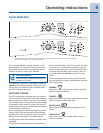
4
Safety
PREVENT FIRE
Do not dry items that have been previously •
cleaned in, soaked in, or spotted with gasoline,
cleaning solvents, kerosene, waxes, etc. Do not
store these items on or near the dryer. These
substances give off vapors that could ignite or
explode.
Do not place items exposed to cooking oils in •
your dryer. Items contaminated with cooking oils
may contribute to a chemical reaction that could
cause a load to catch fi re.
Do not dry articles containing rubber, plastic •
or similar materials such as bras, galoshes,
bath mats, rugs, bibs, baby pants, plastic bags
and pillows that may melt or burn. Some rub-
ber materials, when heated, can under certain
circumstances produce fi re by spontaneous
combustion.
Clean the lint screen before or after each load. •
The interior of the dryer, lint screen housing and
exhaust duct should be cleaned approximately
every 18 months by qualifi ed service personnel.
An excessive amount of lint build-up in these ar-
eas could result in ineffi cient drying and possible
fi re. See Care and Cleaning.
Do not obstruct the fl ow of ventilating air. Do not •
stack or place laundry or throw rugs against the
front or back of the dryer.
Do not spray any type of aerosol into, on or near •
dryer at any time.
Do not use fabric softeners or products to elimi-•
nate static unless recommended by the manu-
facturer of the fabric softener or product.
Do not continue to use the dryer if you hear •
squeaking, grinding, rubbing or other unusual
noises. This could be a sign of mechanical
breakdown and lead to fi re or serious injury.
Contact a qualifi ed technician immediately.
Failure to comply with these warnings could •
result in fi re, explosion, serious bodily injury and/
or damage to the rubber or plastic parts of the
dryer.
PROTECT CHILDREN
Do not allow children to play on or in the dryer. •
Close supervision of children is necessary when
the dryer is used near children. As children grow,
teach them the proper, safe use of all appliances.
Destroy the carton, plastic bag and other pack-•
ing materials after the dryer is unpacked. Chil-
dren might use them for play. Cartons covered
with rugs, bedspreads or plastic sheets can
become airtight chambers.
Keep laundry products out of children’s reach. •
To prevent personal injury, observe all warnings
on product labels.
Before the dryer is removed from service or •
discarded, remove the dryer door to prevent ac-
cidental entrapment.
Failure to comply with these warnings could •
result in serious personal injuries.
WARNING
FIRE HAZARD
A clothes dryer produces combustible lint.
The dryer must be connected to an outdoors
exhaust. Regularly inspect the outdoor exhaust
opening and remove any accumulation of lint
around the opening and in the surrounding area.
Do not operate the dryer if the lint screen is •
blocked, damaged or missing. Fire hazard, over-
heating and damage to fabrics can occur.
WARNING - RISK OF FIRE
To reduce the risk of fi re, electrical shock, or injury to persons when using this dryer, comply with the
basic warnings listed below. Failure to comply with these warnings could result in serious personal
injuries.
You can be killed or seriously injured if you don’t follow these Important Safety Instructions:


















